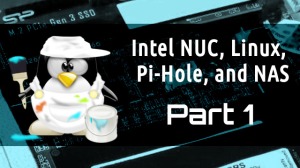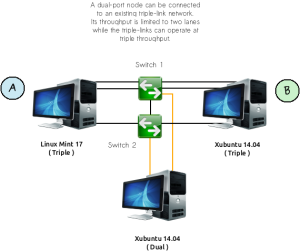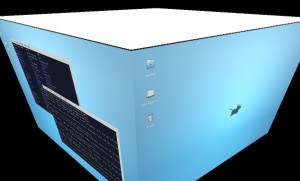Posts Tagged xubuntu
Intel NUC, Linux, Pi-Hole, and NAS – Part 1: The Hardware and Xubuntu 19.10
Posted by delightlylinux in linux on November 2, 2019
📅 November 2, 2019
 Have you heard of an Intel NUC?
Have you heard of an Intel NUC?
A NUC (Next Unit of Computing) is a full-fledged computer system packed in a small — SMALL! — compact case that utilizes minimal power. Almost anything you can do with a desktop system you can also do with a NUC, and the performance is about equivalent to a desktop system depending upon the version of NUC you are using. It is great for a light-weight, miniature computer system, and it supports Linux!
I had the chance to play with a NUC and Xubuntu 19.10 lately, and this is the first of a multi-part series of articles that shows a few adventures I had with it.
The goal is to build a standalone Xubuntu 19.10 computer system running Pi-Hole, acting as a NAS (complete with FTP and SSH servers), and utilizing link aggregation (bonding) using two gigabit Ethernet ports to double the network throughput to 2Gbps instead of 1Gbps to test DLNA media server features.
This first part will focus on the hardware side of things, benchmarking NVMe and SSD performance with CrystalDiskMark in Windows 10, and then installing Xubuntu 19.10.
Ready? Let’s get started!
Xubuntu 16.10 Runs Well in VirtualBox
Posted by delightlylinux in linux on November 9, 2016
📅 November 9, 2016
 The 16.10 versions of Ubuntu and its derivatives were released last month.
The 16.10 versions of Ubuntu and its derivatives were released last month.
Xubuntu 16.10 is available for download, and, after trying it out with VirtualBox, I can say that it runs well and continues its tradition of familiarity and stability combined with a responsive user interface.
Linux Mint 18, Ubuntu 16.04, Xubuntu 16.04, and the Samsung 950 Pro 256G M.2
Posted by delightlylinux in linux on April 21, 2016
📅 April 21, 2016
 Ubuntu 16.04 was released earlier today (April 21, 2016), and it feels like Christmas!
Ubuntu 16.04 was released earlier today (April 21, 2016), and it feels like Christmas!
This also means that the Ubuntu derivatives, such as Xubuntu 16.04, will also be available. In fact, Xubuntu 16.04 is also available for download today. Plus, 16.04 is the Long Term Support version (LTS), making it a replacement for the venerable and reliable 14.04.
With two new operating systems available, how will they handle the Samsung 950 Pro M.2 NVMe 256G SSD? Will Ubuntu/Xubuntu 16.04 install? What will boot times be like?
Update: This article has been updated to include results for Linux Mint 18 Cinnamon.
Hide Files with .hidden
Posted by delightlylinux in linux on June 3, 2015
📅 June 3, 2015
 Do you have files or directories that you wish to hide but do not want to rename as hidden dot files?
Do you have files or directories that you wish to hide but do not want to rename as hidden dot files?
Here is a nifty trick that will hide all specified files and directories without the need to rename them.
All you do is create a hidden file named .hidden (with the dot) in the directory containing the files you wish to hide. When the file manager refreshes, the listed files will no longer appear.
Let’s see the details…
Unable to Update Linux Due to Problem With MergeList Error
Posted by delightlylinux in linux on September 18, 2014
⌚ September 18, 2014
 During a recent attempt to update Linux Mint and Xubuntu, I ran into an issue that I had never seen before.
During a recent attempt to update Linux Mint and Xubuntu, I ran into an issue that I had never seen before.
Ubuntu Software System and Synaptic would both close immediately. No system updates or software installations or removals could be performed even though the system ran fine.
Attempting to update from the terminal also returned a wealth of errors that always reported a Problem with MergeList error.
Update September 24, 2014: This issue has apparently been fixed after performing a recent system update. Several programs, including apt-utils, have been updated in the repository, and the MergeList and Hash Sum mismatch problems no longer occur. The cause of this problem was most likely a software issue that has now been corrected.
Speed Up Your Home Network With Link Aggregation in Linux Mint 17 and Xubuntu 14.04
Posted by delightlylinux in linux on July 12, 2014
⌚ July 12, 2014
 Would you like to have a faster home network? Do you have any spare network interface cards (NICs) lying around unused? Do you run Linux?
Would you like to have a faster home network? Do you have any spare network interface cards (NICs) lying around unused? Do you run Linux?
If yes, then you can put your spare hardware to good use to increase the speed of your LAN and increase its fault tolerance. Link aggregation, also known as port trunking or bonding, lets you pair a group of network cards together so they operate as a single, faster logical network card.
Despite the intimidating name, link aggregation in Linux is inexpensive, simple to set up, and supported natively. No need for special vendor drivers or program recompilation. Once set up and running, operation is transparent to programs. Just use the network like you normally would.
This article shows how to set up link aggregation in Linux Mint 17 and Xubuntu 14.04 using everyday, consumer-grade gigabit networking hardware. Stuff you might already have. Nothing fancy, complex, or exotic. Throughput boosts from 1 Gb/s to 2 Gb/s or 3 Gb/s depending upon the number of network cards and ports used.
Installing Xubuntu 14.04 on the Acer S3 Ultrabook
Posted by delightlylinux in linux on April 28, 2014
⌚ July 16, 2014
 Does Xubuntu 14.04 run on the Acer S3 Ultrabook?
Does Xubuntu 14.04 run on the Acer S3 Ultrabook?
Yes, it does, and Xubuntu runs as stable and as fast as its predecessors.
I have been running Xubuntu 14.04 on the Ultrabook for the past several days, and I am pleased with the results. The S3 Ultrabook is a fine computer, but Xubuntu, like many other Linux distributions, can exhibit quirky behavior depending upon the hardware, so here are a few suggestions based on my experience to help Xubuntu install and run with Compiz desktop effects on this slim netbook.
This article covers following points:
- Installation and partitioning for SSD and hard drive
- Encryption issues
- Kernel 3.14.2
- Adjust the backlight using keyboard shortcuts
- Compiz and Emerald
- R.A.T.7 and M.M.O.7 Support
- Power Management (Fix the display blanking issue that occurs when blanking is disabled)
Xubuntu 14.04 Released
Posted by delightlylinux in linux on April 17, 2014
⌚ April 17, 2014
 It’s finally here! An already excellent operating system is improved once again and launched into the Linux galaxy.
It’s finally here! An already excellent operating system is improved once again and launched into the Linux galaxy.
Xubuntu 14.04 LTS was released today (April 17, 2014) along with the other *buntu distributions, such as Kubuntu 14.04 and Ubuntu 14.04, and I am quite pleased. After installing and performing a cursory experimentation with the 64-bit version, and I am definitely happy with what I see.
SSD or HDD: Which is Faster for a Virtual Machine?
Posted by delightlylinux in linux on April 16, 2014
⌚ April 16, 2014
 If a virtual machine loads and runs from a mechanical hard drive (HDD) or from a solid state drive (SSD), which drive offers faster performance?
If a virtual machine loads and runs from a mechanical hard drive (HDD) or from a solid state drive (SSD), which drive offers faster performance?
Certainly, the SSD will be faster, but by how much? How about some numbers and graphs for comparison? Utilizing my super-scientific timing techniques (a stopwatch), I tested Xubuntu 13.10 in VirtualBox 4.3.10 on both a 5400 RPM and an SSD to see how much the drive affects VM operation and load times.
Here are the results.
Xubuntu 13.10, Compiz, and Emerald
Posted by delightlylinux in linux on April 14, 2014
⌚ April 14, 2014
 Ah, Compiz. The graphical darling of the Linux world that instantly grabs people’s attention and makes them ask, “Cool! How can I make my computer do that?”
Ah, Compiz. The graphical darling of the Linux world that instantly grabs people’s attention and makes them ask, “Cool! How can I make my computer do that?”
Ah, Compiz. Why must you be so quirky?
Before Unity and GNOME 3, Compiz and Emerald were easy to setup and run most of the time. The Ubuntu 10.10 era made the process simple, and Linux Mint 10 was even simpler.
These days, Compiz and Emerald can be a struggle. Are they feasible on today’s distributions? Yes, but… Being a tremendous fan of Compiz and Emerald, I resolved to make them work in Xubuntu 13.10 and Linux Mint 16 MATE, and this led to contradicting results yearning for the “good ol’ days.”